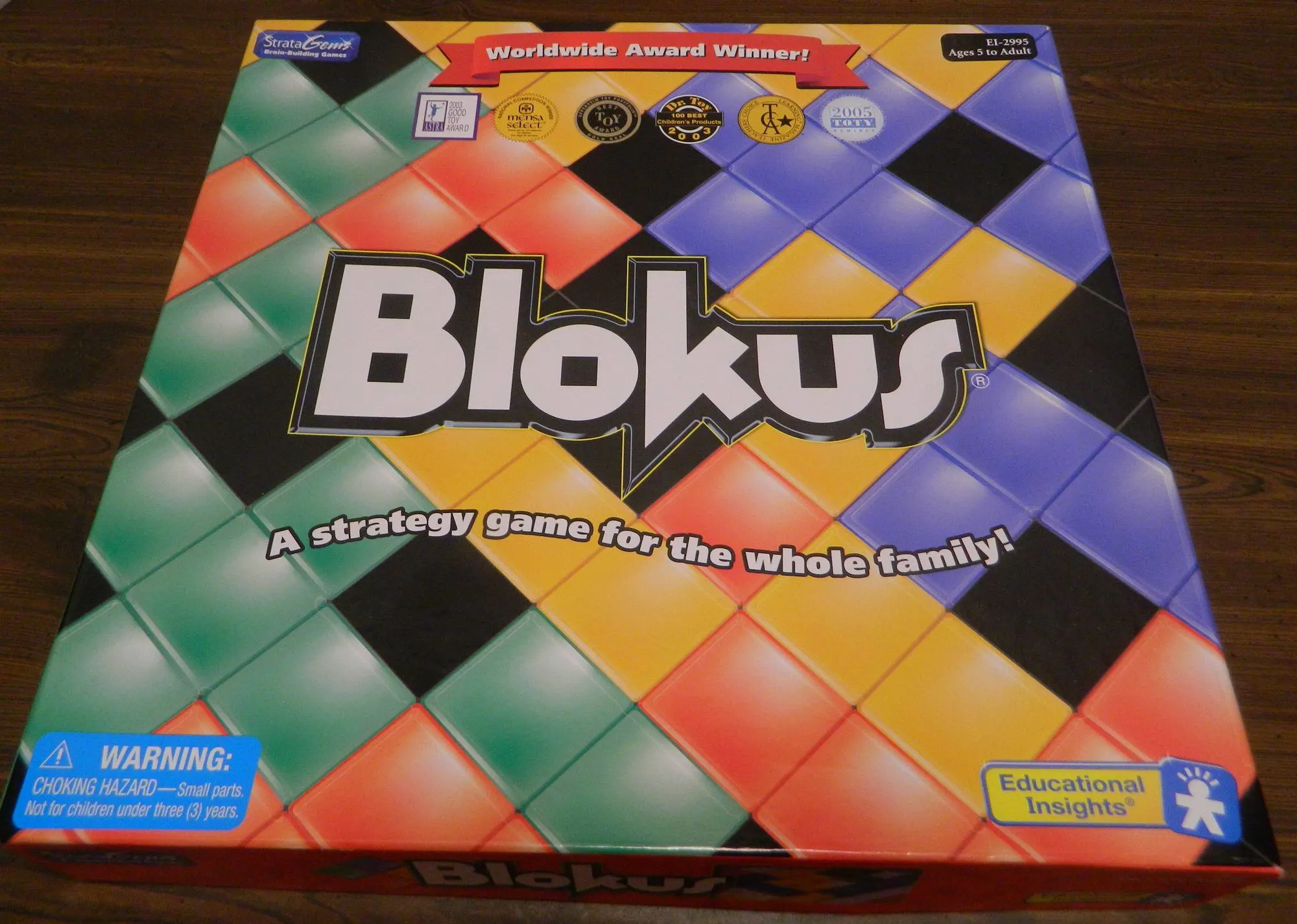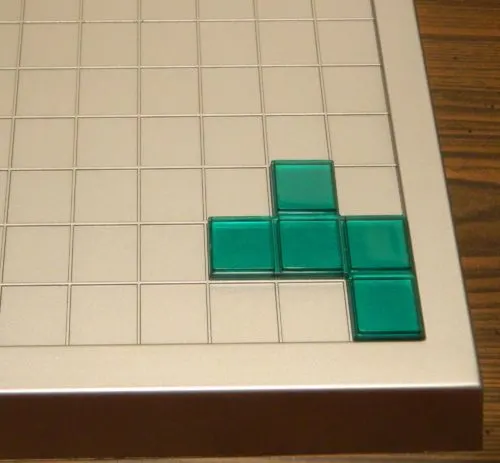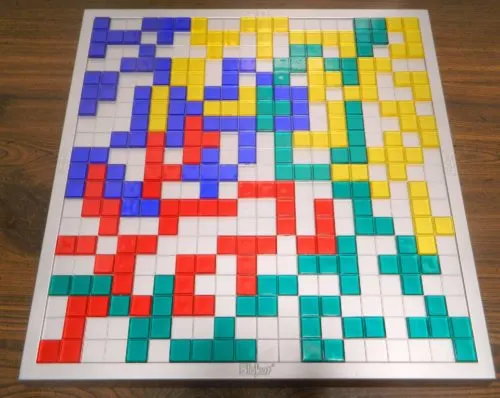Originally created back in 2000, Blokus has become one of the more popular mainstream games created in the 2000s. It has been nominated for and won quite a few awards over the years. Despite being a popular game, I have to admit that I had never played Blokus until recently. I am not exactly sure why as the concept behind the game was interesting, it is generally well liked (it is currently ranked around the 500th best board game of all time on Board Game Geek), and it even appeared to have quite a bit of strategy. While I am not a huge fan of abstract games, I don’t mind them either. While it took me a while to finally try out the game, I had pretty high expectations for Blokus. Blokus doesn’t quite live up to its reputation, but it is still a good abstract game that is simple enough for the whole family to enjoy.
How to Play Blokus
Setup
- Place the gameboard in the center of the table where everyone can reach it.
- Each player chooses a color and takes the 21 pieces of that color. They will place the pieces in front of themselves.
- The turn order for the game is as follows: blue, yellow, red, green.
Playing the Game
On each player’s first turn they will play one of their pieces onto one of the corner spaces. You can play any piece but one of the squares of the piece has to cover the corner space.
After everyone has played their piece, every other piece that players play will have to touch the corner of one of the other pieces that they have already played. This means that no side of a piece can touch the side of another piece of the same color. The player can choose to play any of their remaining pieces as there is no requirement for which piece has to be played next as long as the chosen piece fits on the board.
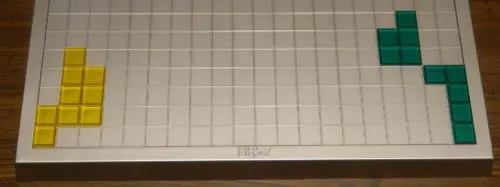
The green player has legally played their second piece as it touches the corner of a previously played piece. The yellow player has illegally played their second tile as it touches the sides of a previously played tile.
While pieces of the same color can’t share a side, pieces of different colors can be played against one another.
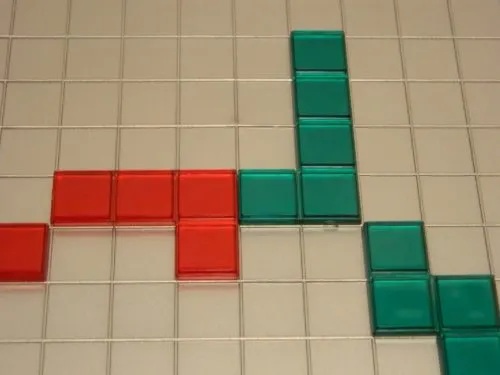
The green player has played one of their tiles next to the red tile. This is legal as it can share a side with a tile of a different color
Once a piece has been played, it cannot be moved for the rest of the game. Play then passes to the next player based on the order described in the setup section.
End of Game
When a player can no longer legally play one of their pieces, they will sit out for the rest of the game. Once all of the players can no longer play a piece, the game ends. Players will then tally up their scores to determine the winner.
A player determines their score by counting up how many squares are on the pieces that they were unable to play. Each square on the unused pieces is worth -1 point. If a player plays all of their pieces they will score 15 points. If the last piece they played was the one square piece, they will also score a bonus five points.
The player who scores the most points or least negative points wins the game.
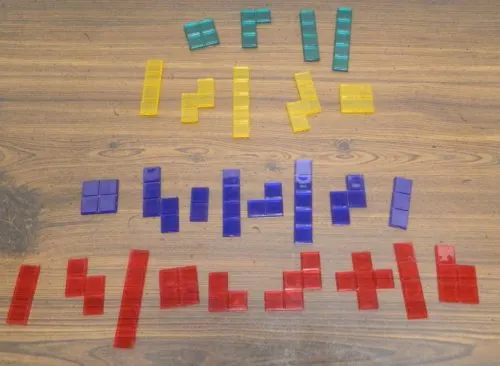
The players have scored the following points: green -17, yellow -22, blue -30, and red -38. The green player has scored the highest with -17 points and has won the game.
My Thoughts on Blokus
On the surface Blokus feels like many other abstract strategy games that involve playing tiles. Players take turns playing tiles to the board with the ultimate goal of playing all of their tiles or at least more tiles than the other players. As you share the board with other players you need to play your tiles in a way that protects your own position while blocking off the other players. If this was all that there was to Blokus it would have made for a solid if not highly original game. There would have been strategy in figuring out where to play your pieces to give yourself more places to play tiles while also minimizing where the other players could play.
Before playing Blokus I assumed that the gameplay revolved around playing tiles next to your other tiles that were already on the board. While close that is not exactly how you play Blokus. Instead of playing tiles next to one another, the key to Blokus is that you have to play tiles so they only touch the corners of your other pieces. At first this might not sound like much outside of being a little quirk that makes the game a little more confusing for first time players. This little mechanic though is one of the reasons why Blokus exceeds other similar abstract strategy tile laying games.
Having to play your pieces where they only touch the corner of one of your other pieces is important because it adds quite a bit of strategy to the game. Most players will begin the game by creating a line of blocks heading from their corner to the center of the gameboard. This is probably obvious for most players but it is usually a good strategy because it gives you more options for the rest of the game. Without this tiny little rule tweak though the game would hit a roadblock when all of the players reached the center of the gameboard. As all of the players would reach the center at around the same time, they would run into one another creating a wall. Since you would have to play a tile next to your own tiles this would create barriers for all of the players. Once all of the players converged they would have to head back to the area they already claimed and start filling it in. The competition for space would be fierce at first and then would die down quickly as players just found the best combination of pieces to fill up the rest of the space that they had already claimed.
Having to play pieces that only touch the corners of previously played pieces totally changes this though. At least early in the game it is very hard to totally block off another player. As you can’t play a piece next to one of your other pieces, you are forced to leave in an opening for another player to move into the area that you claimed at the beginning of the game. If you have the right tiles left and use them properly you can open up new areas of the gameboard for you to play pieces to. A lot of the fun in Blokus comes from finding ways to move around your opponents’ pieces.
Playing at the corners also adds quite a bit of strategy to the game. At first it is a little odd only being able to play tiles that touch at the corners. Once you adjust to the mechanics though, they are quite satisfying. In a lot of these type of abstract tile laying games, the goal is to try and use up every space. In Blokus you want to use up the territory you claim at the beginning of the game as best as you can. The key to doing well in Blokus though is figuring out how to move around your opponents’ pieces. This requires smart play of your tiles.
Blokus might sound pretty basic but the game is a lot deeper than it first appears. When some players first start playing the game they may think that there isn’t a lot of strategy to the game. You are just playing tiles to a grid after all. There is actually quite a bit of strategy to the game though. To do well in the game you need to think about how you are going to use your pieces which requires you think about where you want to go on your future turns. Generally speaking you probably want to use your larger or odder looking pieces earlier in the game as they will be harder to get rid of later in the game. As you progress through the game you can start using your smaller tiles in order to maximize space or move into areas blocked off by your opponents.
Despite the game having quite a bit of strategy, Blokus is also really easy to play. Basically the only rule in the entire game is that you can’t play one of your tiles next to one of the edges of a tile that you have already played. Due to basically only having one rule, you can teach the game to new players within a minute or two. The game has a recommended age of 5+. The rules are simple enough for five year olds to understand. I don’t know if they will really understand the strategy though as they will likely just randomly play tiles to the board. I would guess the game would be better for children a couple years older. With how simple the gameplay is it should also appeal to people that don’t play a lot of board games. Have a friend or family member that will only play games like Monopoly or other mainstream games because they don’t want to play anything too difficult? Blokus is a great compromise as it is easy to play and yet has quite a bit of strategy.
I think the reason why Blokus has succeeded as much as it has is because it feels like the perfect combination between simplicity and strategy. I see Blokus as a game that is easy to learn but hard to master. You can learn the game in minutes and play relatively well. To get really good at the game though will require practice/experience. Blokus seems like the type of game that you get noticeably better at the more you play it. It is a good thing that Blokus is enjoyable enough that you will want to play it enough to improve your skills.
While I really enjoyed playing Blokus, the game does have some issues which prevent it from being perfect.
I would say that the biggest problem with the game is that your fate is not always in your hands. In theory Blokus relies on no luck as the player who makes the best moves and has the best strategy should win the game. This is probably the case most of the time. There are times where your fate can be impacted by the other players though. This is because it is possible for players to gang up on another player. Usually the best strategy is to play tiles towards the middle of the board in order to spread out and give you more options later in the game. The player to your left and right can impact this strategy though. If the two players next to you work together they can cut you off which will severely limit where you can end up playing pieces. Unless you make a great play allowing you to expand outward, these two players could significantly decrease your odds of winning the game. This is why I would not recommend playing with three players as two players could easily gang up on the player seated between them.
The second problem that I had with the game is that it is important to get off to a good start. In the early game you want to spread out as much as you can as it gives you more options later in the game. If you fail to spread out you are going to have a hard time winning the game. At around the halfway point you will already have a good idea of which players will have a good chance of winning and which don’t have much of a chance. While the game will usually only take 20-30 minutes, I have never been a fan of games where some of the players are basically eliminated a while before the game is over. For this reason I wish the game either gave players a few more small pieces or some oddly shaped pieces which would make it easier to sneak around the other players.
The third “problem” is not going to apply for everyone. Blokus is an abstract game through and through. This means that it has all of the positives and negatives associated with the genre. Blokus has basically no theme and thus relies entirely on the gameplay mechanic of playing tiles to a grid. Personally I wouldn’t consider myself to be a fan of the abstract genre, but I don’t hate it either. I had fun with Blokus. People who don’t like abstract games though probably won’t like it. If you don’t find the idea of playing tiles to a grid to be very interesting, you will likely be bored by Blokus.
All of this leads to Blokus being a good game that is still a little overrated. As I mentioned earlier at the time of this review Blokus is rated between the 500th to 600th best board game of all time. That might not sound all that impressive to some people, but with hundreds to thousands of board games released every year being rated that high is quite good. While I really enjoyed Blokus I don’t think it is quite worthy of all of the acclaim it has received. I would have no problem playing the game every so often, but I don’t see it as the type of game that I would play all of the time.
As far as the components for Blokus it is going to somewhat depend on which version of the game you are looking at as there have been quite a few different versions created over the last 19 years. I ended up playing the 2005 Educational Insights version for this review. Basically the components consist of a plastic gameboard and tiles. There is nothing particularly special about the pieces, but they are colorful and durable. I think the thing I liked most about the Blokus components is that when you are done with the game you end up with an interesting colorful abstract picture.
Should You Buy Blokus?
In the board game industry it is pretty hard to create a board game that is still relevant 19 years after it was first created which is something that Blokus achieved. While I think Blokus is a little overrated, I still think it is a good game. I think the main reason that Blokus has been as successful as it has been is that it finds the perfect balance between being accessible while still having enough strategy. The whole family can enjoy Blokus including people who rarely play board games. For such a simplistic game though there is a surprisingly deep level of strategy. Figuring out how to play tiles to move around the other players’ pieces requires some strategy and is quite satisfying. Blokus is the type of game that you will get better at the more you play it.
Blokus does have a few issues though. It is not that hard for two players to gang up on another player. You also need to get off to a good start or you likely will have a hard time getting back into the game. There is also the fact that it is an abstract strategy game. Blokus is a good game, but I don’t see it convincing people that have never liked abstract strategy games.
My recommendation comes down to whether you like abstract strategy games and if the concept sounds interesting. If you have never liked abstract strategy games and don’t care for Blokus’ concept, I don’t see the game being for you. If you are looking for a fun accessible abstract strategy game that the whole family can enjoy though, you should enjoy your time with Blokus.
If you would like to purchase Blokus you can find it online: Amazon, eBay

